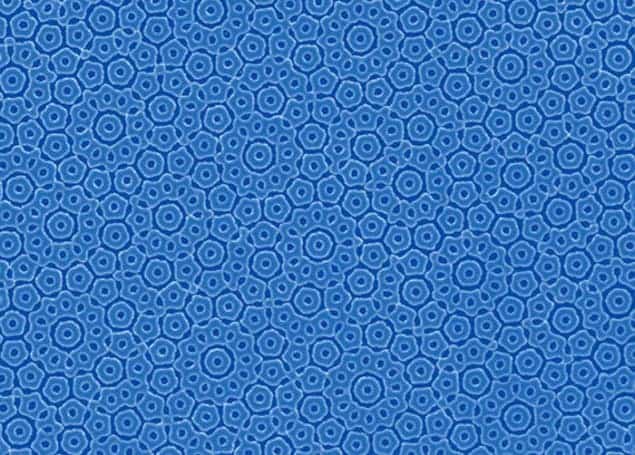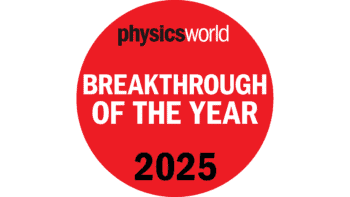
Researchers in the US have invented a new nanofabrication technique that can generate 2D patterns with very high rotational symmetries over large areas. Until now, only spatially repeating structures – which have sixfold or less rotational symmetry – could be patterned over such large areas using industrial photolithography techniques.
Dubbed moiré nanolithography, the technique can produced patterns with rotational symmetries as high as 36-fold – something that has never been observed in nature. Such high rotational symmetries could prove useful for a huge range of applications, from making better photonic crystals to boosting the performance of photovoltaic devices.
Until the 1980s most researchers thought that long-range order in physical systems was impossible without spatial periodicity. They believed that atoms were packed inside crystals in symmetrical patterns that were periodically repeated over and over again, and that this repetition was necessary to obtain a crystal.
Quasicrystals break the mould
In 1984 Daniel Shechtman of the Technion-Israel Institute of Technology discovered quasicrystals – materials that have ordered but not periodic structures. Shechtman made his discovery while studying samples of an aluminium–manganese alloy and found that the atoms in these crystals were packed in an icosahedral pattern that could not be repeated but which had “10-fold” rotational symmetry.
A system is said to possess n-fold rotational symmetry if it looks the same after it has been rotated through 360/n degrees. A sample with 10-fold rotational symmetry therefore remains unchanged after being rotated through 360/10 = 36 degrees. Before Shechtman’s discovery, a 2D ordered system was only supposed to have either one-, two-, three-, four- or sixfold rotational symmetry, with anything else being forbidden by the laws of crystallography.
Since 1984, scientists have discovered hundreds of different quasicrystals – some of which have properties of technological interest – and Shechtman bagged the 2011 Nobel Prize in Chemistry for his efforts.
36-fold rotational symmetry
Now, a team led by Teri Odom at Northwestern University has created 2D quasicrystal nanostructures with a staggering 36-fold rotational symmetry using a new moiré nanolithography technique. Moiré patterns have been known for a long time and can be seen in the everyday world by placing two pieces of fine mesh one on top of the other and then rotating them to create new, more complicated patterns. As you keep on turning, the patterns change as in a kaleidoscope.
Moiré nanolithography relies on the interference of two repeating patterns overlapped at a specific angle, explains Odom. 2D periodic patterns can be routinely fabricated by photolithography over large areas, but these arrangements have sixfold rotational symmetry at most – like a hexagonal lattice. Other high-rotational-symmetry quasicrystals have become popular in recent years (the most well known and highest being the 12-fold symmetry ones), but these must be patterned through serial lithography methods, such as focused-ion-beam milling and electron-beam lithography, which are time-consuming and expensive.
Moiré exposures
“We succeeded in making nanopatterns with rotational symmetries higher than any quasicrystals previously reported by performing two or more exposures through patterned poly(dimethylsiloxane) (PDMS) elastomeric masks,” Odom explains. “Because we first make the patterns in a photoresist, we can then transfer the moiré pattern onto a wide range of materials, from silicon to metals. We can then fabricate omnidirectional reflectors or electrodes, for example, using these structures fairly easily.”
One area in which such high-symmetry moiré nanopatterns might have an impact is in photovoltaics, Odom adds. Thanks to their high rotational symmetry, these patterns can trap light with nearly the same efficiency at all angles. This could come in handy for making solar panels that would not need sophisticated trackers to follow the position of the Sun during the day, for example.
And that is not all, because the distances between the features in these high-rotational-symmetry lattices are on the length scale of the wavelength of visible light – about 500 nm – the patterns have the potential to manipulate the flow of light in new and exciting ways. “For instance, we are currently transferring these patterns onto metallic substrates that can trap, concentrate and slow down light via so-called surface plasmon waves,” says Odom. “We are also looking at how nanohole arrays patterned with this moiré technique in metallic sheets can selectively transmit light at specific energies in the optical regime.”
The research is reported in Nano Letters.




